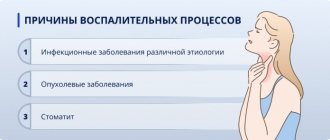Causes of the disease
Doctors distinguish several basic types of pneumonia, each of which has different causes:
- viral – provoked by a viral infection that enters the body;
- bacterial – the root cause of the disease is bacteria of the upper respiratory tract, most often streptococcal;
- aspiration - caused by a foreign body that enters the lungs and provokes the development of inflammation (for example, a piece of food or uncontrolled vomit);
- fungal - develops against the background of lung infection by a fungus.
There are other varieties, but they are much less common. In most patients, the disease is caused by viruses. Most often, this disease occurs in winter, when, against the background of seasonal diseases, excess mucus forms in the lungs, which thickens, does not prevent air from entering the lung structures, and provokes the sedimentation of bacteria and further inflammation.
It is impossible to determine on your own, without medical help, the cause of the disease and its type. Therefore, before treating pneumonia at home, it is necessary to undergo appropriate tests that will allow the doctor to determine an adequate treatment regimen.
Is pneumonia contagious?
The ability to transmit pneumonia from one person to another depends on the type of disease. You cannot become infected with fungal and aspiration inflammation from a patient. This is due to the underlying causes of these types of disease.
In turn, there is a risk of contracting bacterial and viral pneumonia. However, in this case, everything is not so simple. Inflammation itself is not contagious. But microorganisms that became the root cause of inflammation can be transmitted by airborne droplets from a sick person to a healthy one. The danger of contracting an infection persists for a week after the disease develops in the carrier. Moreover, after starting treatment for pneumonia with antibiotics, the risk of infecting someone at home decreases within 2-3 days.
However, even infection with a virus or bacteria does not guarantee the occurrence of inflammation. It can be caused by further improper treatment of influenza, acute respiratory viral infection or other viral infectious disease: too dry air in the room, infrequent ventilation, uncontrolled cough, lack of timely and adequate treatment.
Is it possible to treat pneumonia at home and what medications should be in the first aid kit? We asked a pulmonologist
The disease is not a death sentence, because the lungs are an organ that is completely restored.
Pneumonia is not a new disease, and almost everyone knows about it.
Did you know:
- pneumonia causes death in 15% of children under 5 years of age worldwide;
- Every 64th sick person dies from pneumonia;
- more than 17 million people are diagnosed with pneumonia every year, with men getting sick 30% more often than women;
- Special risk groups include children under 5 years of age and elderly people over 65 years of age.
With the advent of coronavirus, the number of cases of pneumonia has increased significantly. The current epidemiological situation has led to the fact that the day before the patient is not necessarily exposed to severe hypothermia, as was the case before, and does not suffer for a long time from ailments associated with the respiratory tract. The head of the pulmonology department of the 3rd city clinical hospital named after. E.V. Klumova Svetlana Savitskaya.
What you need to know about pneumonia?
According to scientists, the main causative agents of pneumonia are bacteria and viruses; less commonly, it is caused by mycoplasmas, fungi and parasites. In accordance with this, there are three main types of pneumonia: viral, bacterial and fungal.
– Every year, due to the increase in the incidence of viral infections, a peak in the incidence of pneumonia is observed in the autumn-winter period. The coronavirus pandemic, unfortunately, is also often accompanied by pneumonia. This is just viral pneumonia, which, unlike bacterial pneumonia, is not always treated with antibiotics, notes Svetlana Evgenievna.
According to the criterion of the prevalence of the process, pneumonia can be:
- focal - that is, occupy a small focus of the lung;
- segmental - spread to one or more segments of the lung;
- lobar - capture a lobe of the lung;
- confluent - merging of small foci into larger ones;
- total - extends to the entire lung.
In addition, pneumonia can be unilateral or bilateral.
The incidence depends on many factors: standard of living, social and family status, working conditions, contact with animals, travel, bad habits, contact with sick people, individual characteristics of a person, and the geographic distribution of a particular pathogen.
Special attention should be paid to the prevention of pneumonia. For children, this is, first of all, vaccination against Haemophilus influenzae type B, pneumococcus, measles and whooping cough. Reduces illness among people of all ages and combats air pollution. Therefore, you should never forget about the benefits of a country holiday.
– The main precautions now, of course, include maintaining social distance, using PPE and washing hands. Everyone must take care of their own health. Do not forget that in the winter season you should dress according to the weather, and do not forget about a hat. Unfortunately, you can get pneumonia anywhere. In particular, in public transport. Therefore, you always and everywhere need to remember about prevention,” Svetlana Savitskaya gives important advice.
How to recognize the symptoms of pneumonia?
Doctors warn that this disease is quite insidious. At the beginning of its development, it is similar to a cold or flu, which is why it is so difficult to miss the first “bells” and symptoms. Pneumonia is transmitted by airborne droplets, especially if the body is weakened and immunity is low. It can develop if improper treatment is prescribed for bronchitis or flu, as well as against the background of any other respiratory disease and coronavirus.
Depending on what type of pneumonia affects the body, the signs of pneumonia differ. Viral pneumonia is accompanied by a dry cough, headache, high fever, muscle pain, fatigue, and fever. As the disease progresses, symptoms such as cough, temperature, and fever become increasingly stronger, and characteristic chest pain appears.
Bacterial pneumonia can be identified by symptoms such as increased sweating, shortness of breath, rapid pulse, heavy breathing, and a bluish tint to the lips and nails. In addition, symptoms may include bloody discharge when coughing, green-brown sputum, nausea and vomiting with a feeling of shortness of breath, lack of appetite and general lethargy.
Treatment of pneumonia: from home to hospital
Despite the severity of the disease, it is curable in most cases. The main thing is to make a diagnosis in time and see a doctor. The first step to recovery is a chest x-ray. The list of tests that must be taken will include a general urine and blood test, as well as a sputum test.
Depending on the test results, patients are selected for a course of treatment for pneumonia. If the body is infected with a virus, antiviral drugs will help to cope. If the disease developed against the background of staphylococcus or due to Haemophilus influenzae bacteria, antibiotics are used.
The choice of antibiotic depends on the microorganism that caused the pneumonia. To treat the disease, drugs that dilate the bronchi and dilute sputum are also used - orally or in the form of inhalations, corticosteroids, intravenous saline solutions, oxygen. Sometimes pleural puncture and bronchoscopy are performed. Often, specialists prescribe physical therapy: ultraviolet irradiation, vibration massage, physical therapy, paraffin and ozokerite.
It is important to remember that you cannot self-medicate for this disease. At the first warning signs, you should seek help from specialists. With proper treatment, complete recovery occurs within 2 weeks.
“Of course, the more we learn about the new virus, the faster we can cure the patient, including pneumonia,” says the head of the pulmonology department. – But a lot depends on the severity of the disease. In these difficult times, mild pneumonia is still best treated at home. But strictly under the supervision of a doctor. But when it comes to moderate and severe cases of the disease, treatment must be carried out in a hospital. In the most difficult situations, when patients require respiratory support, they are hospitalized in the intensive care unit. Fortunately, the majority of people recover.
However, the doctor notes that recovery from pneumonia caused by coronavirus is longer than after normal pneumonia. Full recovery may take a month or even more. People may be bothered by weakness, shortness of breath, etc. for quite a long time. Indicators such as age and the presence of severe concomitant diseases, for example, cardiovascular, diabetes, cancer and others, play a role here. Unfortunately, they often make the situation worse.
First aid kit for future use - money in the trash
The head of the pulmonology department of the 3rd hospital repeats that pneumonia can be treated at home, but only under the supervision of a doctor.
– Of course, every family should have a home first aid kit. Antipyretic drugs, such as paracetamol and mild antiviral drugs, should be placed there. But there is no point in keeping antibiotics at home. They are mostly available by prescription and often have a limited shelf life. Uncontrolled use of such serious medications will definitely not lead to good. a pulse oximeter (a device for determining the level of oxygen saturation in arterial blood. – Author’s note ). COVID-19 affects the respiratory system, causing the level of oxygen saturation in the blood to drop. A saturation of 96-100% is considered normal, and a decrease below 94% is an alarming sign, shares Svetlana Savitskaya.
Indulging in medications when there is an urgent need has never benefited anyone. But you should always remember about such important effective and at the same time simple preventive measures as proper nutrition and walks in the fresh air.
Natalya MARTSINKEVICH
Photos from open Internet sources
Symptoms of pneumonia
The first sign of pneumonia is a sharp rise in body temperature, which can exceed 38 degrees. Against the background of elevated temperature, general signs of intoxication of the body develop: weakness, fatigue, headache, drowsiness, body aches, pain in the muscles.
After a few days, a dry cough in paroxysmal form is added to the general symptoms. Over time, sputum begins to disappear. Shortness of breath, chest pain and wheezing in adults are serious symptoms of worsening pneumonia and indicate that further treatment at home may be dangerous.
The listed signs are general, and the speed of their development and worsening depends on the specific type of disease. For example, if the inflammation is caused by a virus, the symptoms increase quickly, and the patient’s well-being worsens in just a few hours. With the bacterial form, symptoms, on the contrary, develop gradually, and cough may appear only two weeks after the first signs.
Classification of the disease
The International Classification of Diseases provides for the distribution of pneumonia into seven main types:
- unclassified adenoviral disease;
- unclassified bacterial pneumonia;
- pneumococcal;
- infectious;
- provoked by Haemophilus influenzae;
- arising against the background of other atypical diseases (gonorrhea, typhoid fever, whooping cough, measles, chickenpox, etc.);
- without taking into account the pathogen.
This classification is based on the type of pathogen that provoked the development of inflammation.
HOW PNEUMONIA DEVELOPES
In conditions of reduced respiratory and motor activity, when mucus moves less through the bronchi, against the background of intoxication of the body and decreased immunity, bacteria from the nasopharynx descend into the lower parts of the respiratory tract and can begin to multiply there.
Thus, bacterial bronchitis can be caused first, then bronchopneumonia with transition to pneumonia. The development of bacterial pneumonia can also be facilitated by the patient being on a ventilator for a long time. Despite compliance with all the strictest disinfection measures, ventilators are risk factors for the occurrence of ventilator-associated pneumonia.
Complications
As we have already mentioned, pneumonia is dangerous due to its complications, so treatment regimens for the disease in adults at home using folk remedies are not only ineffective, but can also be life-threatening for the patient. Conventionally, complications caused by tissue inflammation can be divided into two groups: pulmonary and extrapulmonary.
Pulmonary complications affect the respiratory system and include:
- acute respiratory failure;
- pleural empyema;
- gangrene or lung abscess;
- parapneumonic pleurisy;
- respiratory distress syndrome.
Extrapulmonary complications include disorders that occur outside the respiratory system:
- myocarditis;
- septic shock;
- meningitis;
- failure of internal organs and systems;
- DIC syndrome.
Diagnostics
Before treating pneumonia in adults at home or in a hospital, it is necessary to undergo an examination that will help establish a diagnosis, identify the causative agent, clarify the presence of complications and the severity of the pathology. Only after this can the most effective treatment regimen be determined.
The medical diagnostic algorithm for suspected development of pneumonia consists of the following main stages:
- collection and analysis of patient complaints;
- physical examination (measurement of saturation, body temperature, respiratory rate and pulse, listening to the lungs for wheezing);
- laboratory blood tests to confirm the presence of infection, inflammation, as well as sputum analysis to identify causative microorganisms;
- instrumental tests (x-ray or computed tomography, if there is fluid in the pleural cavity - puncture).
Even if the patient’s condition allows for treatment of pneumonia at home, the doctor can give recommendations on taking medications only after receiving diagnostic results.
You can treat pneumonia at home
The treatment tactics for pneumonia directly depend on the causative agent of the disease, the clinical course of the disease, the patient’s age, and the presence of concomitant pathology. Only an experienced doctor can prescribe effective therapy, based on the results of the studies. Pulmonologists at the Yusupov Hospital are leading specialists in Russia who develop an individual treatment plan for each of their patients, taking into account the specifics of the disease and the characteristics of the patient’s body.
Treatment involves taking antibiotics. If you have to wait about a week for test results, the patient is prescribed broad-spectrum antibiotics. If the causative agent of pneumonia is identified, the doctor prescribes the patient a drug to which the infectious agent is most sensitive. In some cases, treatment of pneumonia takes place at home, but with strict adherence to all doctor’s recommendations and regular examination.
Under no circumstances should you take antibiotics or other medications on your own. This is fraught with complications and the transition of pneumonia to a chronic form. Many patients believe that they can find a drug for the treatment of pneumonia in a pharmacy without the help of a doctor, and begin a home course of therapy. In this case, the patient’s condition, as a rule, worsens, and the causative agent of pneumonia develops resistance to the drug. In the future, treating the disease becomes extremely difficult.
If pneumonia is suspected, qualified medical assistance is required. Some people, when sick, are in no hurry to see a doctor. Instead, they prescribe a course of treatment for themselves, go to the pharmacy, and buy a lot of drugs. Sometimes such therapy is effective and the patient recovers. Cold powders cannot cure pneumonia in most cases. Cough syrups will also be ineffective. In many cases, inadequate therapy leads to complications of pneumonia.
For any ailments, consult a doctor. You can make an appointment at the Yusupov Hospital by phone. Experienced and highly qualified doctors will conduct diagnostics in a short time, make a diagnosis and prescribe an effective course of treatment.
Treatment
Pneumonia is treated by a therapist or pulmonologist. Complex therapy involves a combination of several basic approaches that help destroy the causative agent of the disease, remove inflammation and prevent complications:
- Antimicrobial treatment. Treatment of pneumonia with antimicrobial drugs can be done at home, but a doctor must prescribe medications. When fighting pneumonia, macrolides, beta-lactam antibiotics and respiratory fluoroquinolones are often used, but the doctor may choose other groups of drugs. The timing of treatment of pneumonia at home with antimicrobial agents is determined by the doctor; as a rule, the therapeutic period is at least 10 days.
- Non-antibacterial treatment. Involves taking three classes of drugs: immunostimulants, immunoglobulins and glucocorticosteroids. This therapy is used when the disease has already caused serious complications and it is necessary to quickly limit the destructive effect of inflammatory processes on the body.
- Respiratory support. In severe inflammation, the main danger to the patient’s life is acute respiratory failure. Therefore, it is necessary to provide oxygen therapy or artificial ventilation.
Hospitalization is necessary if the patient's age exceeds 65 years, the patient has signs of developing concomitant complications, there are breathing problems, deviations from the normal pulse or blood pressure. After overcoming the acute stage and discharge from the hospital, treatment of pneumonia continues at home with the help of medications prescribed by a doctor.
Hospitalization for pneumonia
Hospitalization may be required if:
- Patient over 65 years old
- Decreased kidney function (little urine)
- Systolic blood pressure below 90
- Diastolic blood pressure 60 mm or lower
- Rapid breathing (30 or more breaths per minute)
- There are signs of impaired consciousness
- Body temperature is below normal
- resting heart rate below 50 or above 100
Hospitalization is carried out either in therapeutic departments or in intensive care units if correction of vital functions is necessary.
Children may be hospitalized if:
- They are younger than 2 months
- They are lethargic or excessively sleepy
- They have trouble breathing
- They have low blood oxygen levels
- They appear dehydrated
Prevention
Prevention is the prevention of infection with viral and infectious diseases. To do this, you should adhere to basic hygiene rules and use simple protective equipment:
- keep your hands clean, wash them as often as possible, especially after sneezing or coughing, use antiseptics;
- cover your nose and mouth when coughing or sneezing with a paper tissue;
- prevent pneumococcal infections with vaccines.
At the first signs of ARVI, influenza or other viral infectious disease, you need to stay home and promptly begin a course of treatment, which in many cases helps prevent the development of complications in the form of pneumonia.
Kinds
Depending on the prevalence of the inflammatory process in the lungs, the following types of pneumonia are distinguished:
- Segmental;
- Focal;
- Share;
- Total.
The last two forms of pneumonia can only be treated in a hospital setting.
Segmental and focal pneumonia can be treated at home with antibacterial and symptomatic drugs prescribed by a doctor. When diagnosed with pneumonia, regardless of the choice of treatment tactics, the patient must regularly visit a medical facility.
It is best to treat pneumonia in a hospital setting. This will allow you to monitor the patient’s condition, make timely adjustments to treatment and prevent the development of complications. The rooms of the Yusupov Hospital have everything necessary to make each patient’s stay as comfortable as possible. There is little here that reminds us of the hospital. The interior is made in pleasant colors, creating a homely atmosphere. The beds are very comfortable. If desired, you can change their position. Each room has a private bathroom. The rooms have TVs with the maximum channel package, and there is also access to the Internet and Wi-Fi.
The windows offer a beautiful view of the hospital park area. The patient (in the absence of contraindications) can always leave the room, walk around the hospital grounds, breathe fresh air, read a book on a bench or talk with relatives. Treatment of pneumonia in an inpatient setting at the Yusupov Hospital will be quick, effective and comfortable.
If the patient decides to treat the disease at home, then it is imperative to follow all the doctor’s recommendations, and if their health worsens, immediately seek help from a doctor. In combination with pharmaceutical drugs, doctors allow treating pneumonia at home using a decoction of some medicinal herbs that have an anti-inflammatory effect.
Make an appointment









